New silicon-based ultrasonic sensors stand ready to join silicon pressure sensors and accelerometers as popular and cost-effective microelectromechanical system (MEMS) sensors.
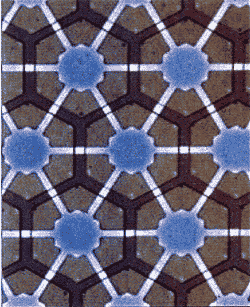 |
| Photo 1. Sensant's silicon ultrasonic sensors use drums built on the surface of the silicon to emit and receive ultrasound. |
The new sensors benefit from the economies of scale found in semiconductor manufacturing and are well suited for high-volume applications that demand high-performance sensors at low costs. The sensors also offer a high degree of reliability and consistent performance found in other MEMS sensors.
Operating Principles
Like MEMS pressure sensors and accelero-meters, silicon ultrasonic sensors use a suspended membrane. From a conceptual standpoint, the sensors resemble thousands of tiny drums on the surface of a silicon chip, where each is only as large as the width of a human hair (see Photo 1). The drum structure consists of a thin nitride membrane and aluminum electrode suspended over a cavity. Nitride sidewalls support the membrane above the silicon substrate that forms the bottom electrode (see Figure 1).
The drums are capacitive structures that operate under an applied electrostatic field. A DC bias voltage applied across the top and bottom electrodes establishes an electric field that creates tension in the nitride membrane. An AC signal voltage applied across the membrane varies the tension and causes it to vibrate and emit ultrasonic waves. Conversely, during reception of ultrasound, an acoustic wave impinges on the top electrode membrane and causes the membrane to move. The movement alters the capacitance of the sensor and creates an output current. For air or gas applications, the sensor operates in a resonant mode to maximize its sensitivity. However, in immersion or water applications, the sensors are designed to be nonresonant for optimal pulse-echo signal quality and broadband frequency response.
The Manufacturing Process
To manufacture these sensors, several layers of thin films are deposited on the surface of a silicon wafer. These include a sacrificial layer, a nitride membrane, and an aluminum top electrode. A portion of the sacrificial layer is then removed to form a cavity beneath the nitride
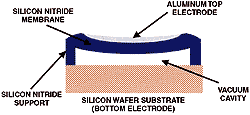 |
| Figure 1. Silicon sensors resemble tiny drums with a thin, ultrasensitive nitride membrane that vibrates to send and receive ultrasound. The membrane and the underlying silicon substrate form the top and bottom plates of a capacitor. Changes in the voltage on the capacitor displaces the nitride membrane, and displacements of the membrane cause detectable changes in capacitance |
Air Sensor Advantages
MEMS technology affords silicon ultrasonic sensors an important design advantage over piezoelectric sensors--a 50 dB better dynamic range in air. Silicon ultrasonic sensors are more efficient at transferring electrical energy into acoustic energy. Their lightweight nitride membrane matches the acoustic impedance of air much better and can therefore create pressure waves more efficiently than a solid piezoelectric crystal. In an application, this translates into orders of magnitude greater dynamic range than typical piezoelectric transducers.
At a 100 VDC bias and with a 10 VAC input signal at 2 MHz, silicon ultrasonic sensors offer a 110 dB dynamic range, defined as the ratio of the amplitude of the strongest measurable signal to that of the noise floor. Comparable piezoelectric sensors offer a dynamic range of only about 60 dB, a 10,000 ×reduction in the sensor's ability to detect acoustic power. The dynamic range of the ultrasonic sensors provides greater flexibility for system designers, enabling new applications (e.g., as air-coupled nondestructive testing of metals and composites).
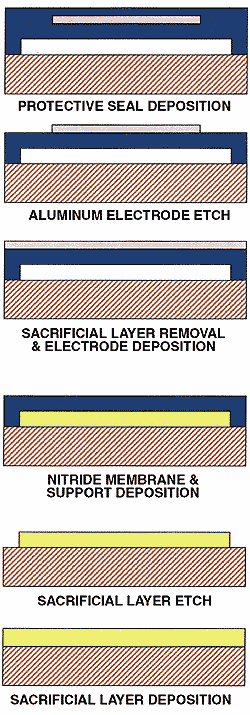 |
| Figure 2. In the silicon sensor manufacturing process, a sacrificial layer is deposited on top of the wafer substrate. A thin nitride membrane is then deposited on top of the patterned sacrificial layer, followed by the deposition and patterning of the top electrode. Finally, the sacrificial layer is removed, and a protective layer seals the device. |
MEMS technology makes it possible for manufacturers to produce air and gas ultrasonic sensors that can operate at higher frequencies (200 kHz to 5 MHz) than most piezoelectric devices (50200 kHz). The ability to make microscopic structures with MEMS technology permits the fabrication of very small drums that emit high-frequency ultrasound. The smaller the drum, the higher the frequency of the ultrasonic signal. For pulse-echo, time-of-flight measurements and Doppler frequency shift detection, the higher frequency results in up to 10 ×better timing and frequency resolution and up to a 10 ×reduction of the dead zone.
Unlike piezoelectric sensors, silicon ultrasonic devices are nearly perfect unidirectional radiators that require no back damping materials and have no observable acoustic coupling with the sensor's supporting structure. The silicon sensors--with a thickness of <1 mm--are typically much thinner than piezoelectric sensors for a given aperture size. The combination of a small form factor and an absence of mechanical coupling facilitates the design of smaller, less expensive systems.
Air/Gas Applications
Nondestructive Testing (NDT). Silicon ultrasonic sensors enable a promising new application: noncontact NDT systems. In noncontact ultrasonic inspection, ultrasound propagates through the air into the material in question and then returns via the air without the use of a couplant gel.
Potential applications of the technology include the inspection of composite materials, aluminum, and plastics for defects, cracks, or delamination. Because contact is unnecessary, the sensors can also be used to inspect material or products on a moving assembly line or in applications in which contamination is a concern. In addition, many existing water-coupled ultrasonic systems could be replaced and the inspection process simplified. An example of an air-coupled scan of aluminum corrosion is shown in Photo 2.
With operating frequencies of 15 MHz, the sensors are frequency-compatible with most existing methods of ultrasonic inspection. Also, because the devices are made in silicon, they can operate in temperatures in excess of 200ºC.
Ranging/Proximity. For ranging applications (e.g., the detection of an occupant's position in an intelligent automobile airbag system), silicon ultrasonic sensors are effective over a broad range of operating distances and offer precise resolution and superior close-range detection. A typical setup uses a 500 kHz sensor with a 2 VAC signal in pulse-echo mode. This yields an active range of ~2100 cm. Separate transmit-and-receive sensors can be built on the same chip to eliminate the effects of ringing for even closer range detection.
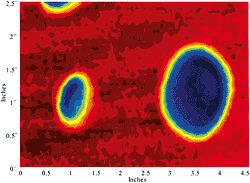 |
| Photo 2. The image shows an air-coupled nondestructive test scan of corrosion in an aluminum plate using a 2 MHz silicon sensor. The blue represents a more distorted ultrasonic signal. This can indicate more severe corrosion or a different type of corrosion. |
For high-precision, short-range measurement applications, 2 MHz sensors can be used with a phase-shift detection algorithm to measure distances or product dimensions with submicron accuracy. For example, a phase-shift algorithm that is capable of detecting a 1º phase shift of a 2 MHz ultrasonic signal would yield a measurement accuracy of 0.5 µm.
Air/Gas Flow Measurement. Silicon ultrasonic sensors for gas flow measurement offer precise time resolution for highly accurate flowmeter designs for natural gas, automotive mass air flow, respiration, and other flow applications.
You can improve meter accuracy because of the sensors' high frequency of operation. Silicon ultrasonic sensors can transmit ultrasound at frequencies between 500 kHz and 2 MHz, an order of magnitude higher than piezoelectric sensors. This allows 10 ×more precise time-of-flight and phase-shift resolution. In addition, the higher frequency of operation is well above the frequencies of ultrasonic noise generated by flowing gas (typically 200 kHz), which can cause inaccurate flow measurements made by meters based on piezoelectric sensors.
Immersion Sensor Advantages
For immersion applications--those applications in which the sensor launches sound into a liquid or gel--silicon sensors offer excellent performance. This type of sensor has substantially improved broadband response and better insertion loss than piezoelectric ultrasonic sensors. These advantages offer the potential for significantly improved signal and image quality for medical and industrial applications.
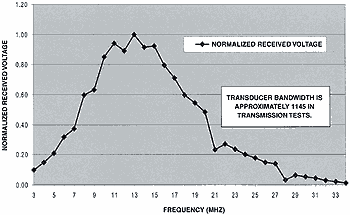 |
| Figure 3. A transmission test shows the normalized received signal of typical 13 MHz silicon ultrasonic sensors. The 6 dB points are at 6 MHz and 22 MHz, yielding a bandwidth of 114%. |
The design of immersion silicon ultrasonic sensors takes advantage of the robust, thin membranes that MEMS technology enables, using them to create a nonresonant ultrasonic sensor with a broad frequency response and improved sensitivity. In liquid applications, the mass of the membrane is negligible relative to that of the liquid. Thus, the electrostatic force on the nitride membrane acts to displace the liquid and generates an ultrasonic pressure wave. This allows the sensors to operate more efficiently across a broader frequency spectrum than a resonant piezoelectric device.
The improved bandwidth of silicon ultrasonic sensors reduces signal ringing and signal distortion. This results in higher resolution for imaging and ranging applications. Sensant's 9 MHz immersion sensors have a bandwidth of more than 110%, compared with a maximum of 80% bandwidth of a state-of-the art medical imaging sensor.
Like their air counterparts, immersion silicon ultrasonic sensors are efficient in water or liquid. Sensors under development by Sensant Corp. perform in water with a one-way peak insertion loss of 11 dB and a bandwidth in excess of 100%. A typical broadband frequency response plot of a 13 MHz silicon ultrasonic sensor is shown in Figure 3.
Immersion Applications
Medical Imaging. With a single silicon ultrasonic sensor capable of transmitting ultrasound from 2 MHz to 15 MHz, imaging system designers can improve tissue harmonic imaging by selecting multiple frequencies to image the patient and can reduce the number of probes used by their imaging systems. In the future, 2D silicon ultrasonic sensor arrays with onchip integrated electronics will let ultrasonic imaging systems provide physicians with 3D images in real time. Already, single-element and 64-element 1D arrays have been built for the medical imaging market.
Liquid Level Detection. Another potential application for silicon ultrasonic sensors is liquid level detection. The broadband characteristics of the sensors allow for better short-range signal detection in pulse-echo operation. The absence of ring up and ring down from the sensors makes the received echo more easily recognizable and facilitates the design or simplification of a level-detection algorithm. Additionally, immersion silicon ultrasonic sensors require no matching layers and are inert to most chemical environments.
Trends for the Future
Future generations of silicon sensors will add system features on the chip to reduce the cost and complexity of ultrasonic systems. New devices with multiple-element sensor arrays have the potential of bringing major advances to NDT and medical imaging applications (e.g., 3D ultrasonic imaging of the human body).
More specifically, integrated electronics may add onchip transmit-and-receive circuitry to simplify board-level system design and to reduce system costs. The basic silicon ultrasonic sensor chip could then evolve into a low-cost, generic ultrasonic transceiver with supporting electronics.
The emergence of 1D and 2D sensor arrays will have a significant impact on ultrasonic imaging applications. With multiple-element arrays, electronic beam steering or focusing is possible, as is off-axis beam radiation. This is particularly relevant for new ultrasound imaging systems for 3D medical imaging, where an ultrasonic beam is scanned across the body to generate a 3D image. Other ultrasonic systems could dynamically monitor the changing position of a target or adapt ultrasonic flowmeters to changing gas flow rates.
For Further Reading
Ladabaum et al. May 1998. "Surface Micromachined Capacitive Ultrasonic Transducers," IEEE Trans on Ultrasonics, Ferroelectrics, and Frequency Control, Vol. 45, No. 3:678-690.
Ladabaum et al. 1998. "Miniature Drumheads: Microfabricated Ultrasonic Transducers," Ultrasonics, Vol. 36:25-29.
X. Jin et al. March 1999. "Fabrication and Characterization of Surface Micromachined Capacitive Ultrasonic Immersion Transducers," IEEE MEMS, Vol. 8, No. 1:100-114.